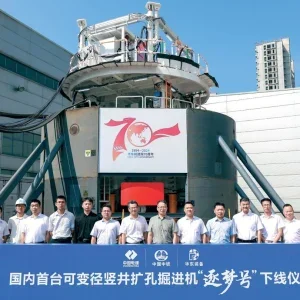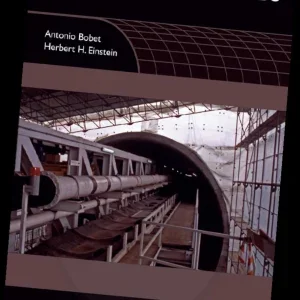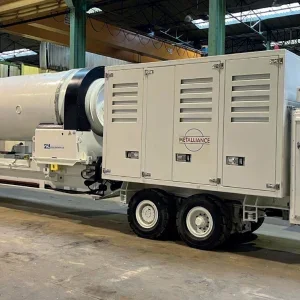On a summer’s day sailboats, canoes and other watercraft dot the Glenmore Reservoir while cyclists cruise the perimeter. Along with the idyllic recreational pastimes of May to October the reservoir, part of the Elbow River, provides at least half of the drinking water for Calgary’s residents.
At the heart of this prized area of Calgary Ward & Burke has successfully constructed a 1,650mm feedermain. Proposing to install sections of the pipeline by microtunnel instead of open cut reduced the impact on the public and the environment.
The project required two main worksites north and south of the river. Brian Fahy project manager with Ward & Burke, explains the launch site, about 50m from the river, was in close proximity to popular spots for fishing, swimming and rafting, as well as home to wildlife. Meanwhile on the south the site was near a well-off residential neighborhood.
The dam itself acts as a key connection for the two riverbanks with a walkway and bike path running along the top, and the existing 1500mm feedermain immediately adjacent to the paths. It was placed directly on the dam’s bridge deck in the early 1980s, explains Patrick Mackie, project engineering – Glenmore Water Resources, Infrastructure Delivery for the City of Calgary. “At the time this was driven by increased water supply demands, and the existing road right-of-way provided essentially the easiest alignment,” he adds that local tunnelling technology was in its infancy at the time.
In 2011, design work started for a project to refurbish the Glenmore Dam, which included a new gate system, concrete repair and other maintenance work. The project evolved to the point where the feedermain could not be left in place. “It simply required more room,” Mackie says. “Also, from a safety and security standpoint, relocation of the exposed water line was preferred given that times and risk levels have changed.
“Essentially, the feedermain relocation project—that also involved moving an existing gas line—was required in a timely manner in order to support the subsequent stages of work on the Glenmore Dam.”
Redesign
Looking at the design for the utility relocation project Ward & Burke saw opportunities to reduce the construction footprint, reduce risks and maintain the schedule.
Initally the project would only have one microtunnel, which would be driven under the Elbow river from the north to south banks. Fahy says they identified a major risk on the north side of the river where the project’s initial design incorporated 170m of open cut construction, which would cross a park, an access road for water treatment personnel, a steel embankment, an access road to the dam for emergency services, and the pedestrian and bike paths.
Sections of this open cut work were to be laid at up to 30 per cent gradient, through water bearing ground with silt and sand, underneath four in-service feedermains 900mm and 1200mm in diameter, two of which supply water to the southern half of Calgary.
Due to the risks associated with this work Ward & Burke proposed installing this section using trenchless methods to construct a 2500mm ID microtunnel at a constant 15 per cent gradient.
“We eliminated the risk of a deep excavation dealing with running soil conditions and groundwater directly under the critical watermain infrastructure for the city,” Fahy explains.
Changing the design to put the pipeline deeper also meant Ward & Burke maintained access for water treatment staff to the facility, as well as emergency services to the dam. No parklands or trees were affected, and the bike path stayed open for the duration of the work, despite its proximity to the project sites. Fahy adds this was approved at no extra cost to the client. “It greatly reduced the impact the project had on the environment, the public, and the water treatment plant staff.”
Another risk Ward & Burke identified was a 52m deep shaft on the south side of the Elbow River to receive the TBM. “By creating a vertical curve in the tunnel under the river we were able to reduce that south shaft from 52m deept to 32m. That eliminates a certain level of risk and cost,” Fahy says. For the Glenmore Dam Utility Replacement Project Ward & Burke proposed changing the design to include construction of 490m of 2500mm nominal diameter microtunnel casing, 30m of 2040mm diameter handjack casing and caisson shafts to support the work.
Waterproof
The caissons, which included one permanent installation, ranged from 8m internal diameter to a 10.4m by 11.8m internal diameter, oval shaped shaft for launching the MTBM (see Table 1). The ground included mixed conditions of shale, boulders, sands and silts. Ward & Burke sank all the caissons into the shale bedrock and designed them to accommodate the anticipated rock formation.
“The reason we went with caissons is because they were very robust,” Fahy explains. “We knew that we had to sink the caisson structure down through about 10-11m of overburden until they came to bear on the bedrock, and then the rest of the shaft had to be excavated to the bedrock.”
Initially they had planned to sink and excavate the caissons down to the bedrock, then switch to an underpinning method, exposing around 2m or so of rock and pouring concrete, repeating the procedure until reaching formation.
“The benefit of going with a robust caisson system was that it allowed us the opportunity to change our shaft excavation method midway through construction, and you don’t get that opportunity with most methods,” he says.
On both the main launching shaft on the north side and the 32m-deep shaft on the south side the caissons reached bedrock and they found the bedrock to be relatively weak. “We were able to excavate the bedrock and continue sinking the caisson to the full depth in both of those shafts, 21m in the launch and 32m in reception.
“What that ensured was a fully water tight structure. We were right beside the reservoir, right beside the Elbow River, and there was water permeating through the bedrock and by being able to sink the caisson full depth, we had a fully sealed shaft by the time we reached the formation and poured our concrete base.”
They were prepared to deal with groundwater from the river that entered the shaft as they excavated the caissons, Fahy explains. “The added benefit of being able to sink the caisson the full depth meant that we were continuously choking off the groundwater from our excavation. We had very minimal ground water in comparison to other methods.”
Microtunnel Drives
For the trenchless components of the utility replacement project the contractor was allowed to use an open face TBM, but at the same time the client expressed concerns about frac outs as the machine passed under the Elbow River.
Fahy says they thought the safest and most robust means of doing the trenchless work under the river and embankment was to use a TBM, “primarily because it’s a fully sealed system.
“We’re jacking concrete pipe directly behind it, so as the machine travels through we’re not concerned about groundwater flow or groundwater pressure at that location because the TBM is 100 per cent sealed. It’s a very safe working environment and there are no concerns passing under the Elbow River.”
Ward & Burke had previously used this Herrnknecht AVD 2500 in Calgary on the 37th Street Storm Relocation project in 2015, in almost identical ground conditions, Fahy says. “There was no concern how the machine was going to perform and advance through the bedrock.”
Using live readings of tunnelling parameters such as the slurry pressure at the front of the MTBM, ensured that the operator was is constant control and regulation of the pressures to avoid a spike in pressures that could cause a frac-out. No soil stabilization or ground improvement were necessary during the microtunnel job.
Fahy stresses it was important to have the right TBM, competent operators and being aware of exactly how much cover was above the machine. Crew members with waders and a leveling staff waded out into the river to do a line of surveys confirming the river bed elevation. A task they were able to undertake in the summer months—the project deployed in May 2016, with installation of the main tunnel under the river in September.
This longer of the two microtunnels was 320m in length, including the vertical curve for a length of 140m (R = 1,000m), and a transition to a constant 15 per cent positive gradient. According to Ward & Burke it’s the steepest microtunnel grade in North America to date.
The contractor proposed using an AWWA C300 design concrete water main as opposed to steel pipe. “It’s a concrete pipe with steel pipe running through it,” Fahy explains, adding: “This pipe has actually been used in Calgary since the 1930s and is still in service. Over the years, it fell out of favor because it was viewed as being a more expensive pipe compared to the more common C301 pressure pipe for water mains.”
The advantages of the C300 were the ability to jack it into the tunnel, its 3m length allowing it to go around the curve, and its flexible concrete pressure pipe joints. “That’s what was key to being able to redesign the alignment under the Elbow River, to introduce a vertical curve, and have a shallower shaft,” he says.
He describes the process, saying as the lining segments are jacked into the tunnel the pieces go around the curve, the outside joints open and they were able to install the entire pipeline into the tunnel. Once the pipeline is fully installed they then welded the joints in place.
The microtunnelling pipe was specifically designed and manufactured by Decast Precast in Ontario for use with the Herrenknecht AVN 2500, and shipped via road to the project site in Calgary. The lining has a 2,500mm ID and a 2,980mm OD. The new pipeline accommodates a 2,050mm OD watermain and a 327mm OD gas main.
Approximately 40m away from the 32m-deep south side shaft Ward & Burke would make the final tie in to the existing pipeline. There was a significant difference in elevation between the two locations.
“To avoid a very deep open cut installation there of about 15m, we proposed doing another short, trenchless section about 25m long. We actually hand mined that above the water table.”
Eliminating the deep open cut section also eliminated the risk of crossing fiber optics and a 900mm feedermain. Crews mined a full face of sandstone/siltstone/ mudstone to a total of 30m length (when combined with the workspace for the tie in). At the end of the utility replacement project the temporary work shaft became a permanent valve chamber for the City.
Tie Ins
It was imperative to maintain the project schedule through the summer months for the shaft construction and the tunnels. The contractor knew the most difficult work would happen in the middle of the winter. From about mid September crews began installing the gas main, followed by performing the work to weld the watermain in place.
Ward & Burke had to connect the new 1650 water main pipe on the north side to two existing feedermains, a 1500 steel pipe and a 1200 pipe. “On the north side we tied-in the 1500 in a three week period from late November to December. During that time we had two very cold weeks of about -20°C to -30°C and that was definitely a challenging part of the project.”
Exposed to the elements, crews took precautionary steps keeping cranes and excavators running over night, and using Frost Fighters portable heating systems. While welding the joints the temperature in the tunnel needed to be at least 10°C, and from November to February it was -16°C to -30°C outside. Fahy describes it as a constant battle to heat the tunnel, while also appropriately ventilating it during the welding operations.
Another tactic was to use hoardings to create enclosures around the tie-ins, reducing the size of the space being heated. Crews completed the welding, sandblasting, coatings and other work on the northside’s 1500 pipe tie in before the Christmas shut down, and returned in the new year to the south side to connect into the existing 1500 pipe. In April they did the last tie in for the 1200 water main on the northside.
“You prefer to be doing that work in the middle of summer,” Fahy says, adding that perseverance and preparation were important. “We didn’t lose schedule in any aspect, whether it’s ground conditions or weather, and we’re very proud of that.”
He says the three tie-ins were the most critical components of the project. “On every other aspect of the job you can plan it and if you encounter a delay, you may get the time back. But once that critical feedermain is shut down for the City of Calgary, you’re on the clock. There’s an element of stress there.” While connecting to the 1500 main water supply to the area’s residents relied on the smaller 1200 pipeline.
“Once they shut down the line you better be 100 per cent prepared to get the work done on time regardless of whether it’s -30°C outside. That’s when it really hit home how critical our work was.”
The project came in on time and on budget. Reducing disruptions on the surface level is the project’s biggest success, Calgary’s Mackie says. “The impact of the project to the public was negligible, and any environmental disturbance was kept to an absolute minimum.
“In hindsight, given the somewhat atypical rains Calgary encountered during construction, an open cut section would have provided a significant challenge, and would have had a substantial social, environmental and economic impact.”






